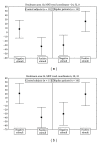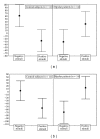Different neural responses to a moral valence decision task in unipolar and bipolar depression
- PMID: 24455401
- PMCID: PMC3877629
- DOI: 10.1155/2013/568617
Different neural responses to a moral valence decision task in unipolar and bipolar depression
Abstract
Objectives. Patients affected by bipolar disorder (BP) and major depressive disorder (UP) share the susceptibility to experience depression and differ in their susceptibility to mania, but clinical studies suggest that the biological substrates of the two disorders could influence the apparently similar depressive phases. The few brain imaging studies available described different brain metabolic and neural correlates of UP and BP. Methods. We studied the BOLD neural response to a moral valence decision task targeting the depressive biases in information processing in 36 subjects (14 BP, 11 UP, and 11 controls). Results. Main differences between UP and controls and between UP and BP were detected in left ventrolateral prefrontal cortex (PFC, BA 47). Neural responses of BP patients differed from those of control subjects in multiple brain areas, including anterior cingulate cortex (ACC) and medial PFC, bilateral dorsolateral PFC, temporal cortex and insula, and parietal and occipital cortex. Conclusions. Our results are in agreement with hypotheses of dysfunctions in corticolimbic circuitries regulating affects and emotions in mood disorders and suggest that specific abnormalities, particularly in ventrolateral PFC, are not the same in UP and BP depression.
Figures





Similar articles
-
Neural and genetic correlates of antidepressant response to sleep deprivation: a functional magnetic resonance imaging study of moral valence decision in bipolar depression.Arch Gen Psychiatry. 2007 Feb;64(2):179-87. doi: 10.1001/archpsyc.64.2.179. Arch Gen Psychiatry. 2007. PMID: 17283285
-
Brain glucose metabolism difference between bipolar and unipolar mood disorders in depressed and euthymic states.Prog Neuropsychopharmacol Biol Psychiatry. 2009 Mar 17;33(2):243-50. doi: 10.1016/j.pnpbp.2008.11.014. Epub 2008 Dec 3. Prog Neuropsychopharmacol Biol Psychiatry. 2009. PMID: 19100808
-
Changes in regional cerebral blood flow following antidepressant treatment in late-life depression.Int J Geriatr Psychiatry. 2008 Aug;23(8):805-11. doi: 10.1002/gps.1980. Int J Geriatr Psychiatry. 2008. PMID: 18214999
-
Differentiating between bipolar and unipolar depression in functional and structural MRI studies.Prog Neuropsychopharmacol Biol Psychiatry. 2019 Apr 20;91:20-27. doi: 10.1016/j.pnpbp.2018.03.022. Epub 2018 Mar 28. Prog Neuropsychopharmacol Biol Psychiatry. 2019. PMID: 29601896 Review.
-
Common and distinct patterns of intrinsic brain activity alterations in major depression and bipolar disorder: voxel-based meta-analysis.Transl Psychiatry. 2020 Oct 19;10(1):353. doi: 10.1038/s41398-020-01036-5. Transl Psychiatry. 2020. PMID: 33077728 Free PMC article. Review.
Cited by
-
Ratio of mBDNF to proBDNF for Differential Diagnosis of Major Depressive Disorder and Bipolar Depression.Mol Neurobiol. 2017 Sep;54(7):5573-5582. doi: 10.1007/s12035-016-0098-6. Epub 2016 Sep 9. Mol Neurobiol. 2017. PMID: 27613282
-
Effect of subclinical depression on moral judgment dilemmas: a process dissociation approach.Sci Rep. 2022 Nov 21;12(1):20065. doi: 10.1038/s41598-022-24473-2. Sci Rep. 2022. PMID: 36414675 Free PMC article.
-
Effects of childhood trauma on adult moral decision-making: Clinical correlates and insights from bipolar disorder.J Affect Disord. 2019 Feb 1;244:180-186. doi: 10.1016/j.jad.2018.10.002. Epub 2018 Oct 5. J Affect Disord. 2019. PMID: 30343121 Free PMC article.
References
-
- McGuffin P, Rijsdijk F, Andrew M, Sham P, Katz R, Cardno A. The heritability of bipolar affective disorder and the genetic relationship to unipolar depression. Archives of General Psychiatry. 2003;60(5):497–502. - PubMed
-
- Bunney WE, Jr., Garland BL. A second generation catecholamine hypothesis. Pharmacopsychiatria. 1982;15(4):111–115. - PubMed
-
- Post RM, Jimerson DC, Bunney WE, Jr., Goodwin FK. Dopamine and mania: behavioral and biochemical effects of the dopamine receptor blocker pimozide. Psychopharmacology. 1980;67(3):297–305. - PubMed
-
- Wehr TA, Goodwin FK, editors. American Handbook of Psychiatry. New York, NY, USA: Basic Books; 1981. Biological rhythms and psychiatry.
-
- Joyce PR, Fergusson DM, Woollard G, et al. Urinary catecholamines and plasma hormones predict mood state in rapid cycling bipolar affective disorder. Journal of Affective Disorders. 1995;33(4):233–243. - PubMed
LinkOut - more resources
Full Text Sources
Other Literature Sources
Miscellaneous

